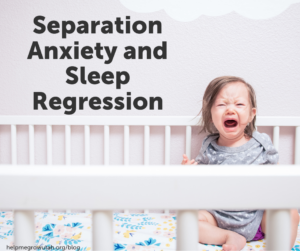 A few months after my grandson’s second birthday, he started having some separation anxiety that led to some trouble with bedtime and sleep regression. He went from a toddler who went to bed and to sleep each night without too many problems and slept without waking too often during the night to a toddler who screamed, cried, and hit his head against the bars of his crib until he had bumps and bruises on his head. His parents tried many things to help him sleep better from letting him cry it out (for hours) to staying with him until he fell asleep (he would wake up as soon as they left the room and it would start all over again). Throughout the time this was happening, my daughter often asked for advice or suggestions. Here are a few things I found for her:
A few months after my grandson’s second birthday, he started having some separation anxiety that led to some trouble with bedtime and sleep regression. He went from a toddler who went to bed and to sleep each night without too many problems and slept without waking too often during the night to a toddler who screamed, cried, and hit his head against the bars of his crib until he had bumps and bruises on his head. His parents tried many things to help him sleep better from letting him cry it out (for hours) to staying with him until he fell asleep (he would wake up as soon as they left the room and it would start all over again). Throughout the time this was happening, my daughter often asked for advice or suggestions. Here are a few things I found for her:
- Check with your pediatrician to rule out a medical reason, such as illness, ear infection, a stuffy nose or teething. If there isn’t a medical reason for your child not sleeping, your pediatrician can most likely give you some tips.
- Sleep regression is normal at certain ages. It is commonly related to separation anxiety, just like my grandson was experiencing, and is a sign that your child is developing normally. This article explains that separation anxiety is a normal part of a child’s mental maturity and shows that a child has developed object permanence.
- Have a bedtime routine to help your child transition from playing to sleeping. Switching gears from doing something fun to something boring, like sleeping, is hard! Establishing or continuing a routine can help this transition go more smoothly. A bedtime routine will look different for every family but could include taking a bath, putting on pajamas and a fresh diaper, reading or telling a story, singing a lullaby, a kiss and a hug goodnight, and then dimming or turning off the lights.
- Evaluate your child’s sleep patterns – is it time to adjust bedtime or naptime or remove a nap altogether? If your child is getting most of her sleep during the day, she is less likely to be tired at bedtime. Sleep requirements change as your child gets older and many children stop napping between the ages of 3 and 5. You can see a list of sleep requirements, including naps, for all children in this article by the Sleep Foundation.
There are many other reasons why a toddler might be struggling with bedtime, such as having nightmares or feeling a lack of control. The Sleep Foundation has an excellent article that discusses these reasons and ways parents can cope; you can read it here. As for my grandson’s separation anxiety and sleep regression, his parents tried many different things but eventually stuck to making sure that he felt loved, his environment was safe, and letting him cry it out. They already had a bedtime routine in place, so they continued their routine. He still has a rough night once in a while but is going to bed and sleeping much better.
You can read more tips about making bedtimes easier by reading my previous blog post Making Bedtimes Smoother





